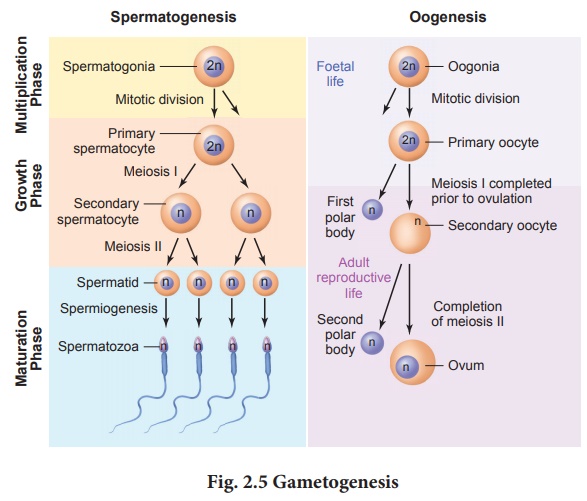In embryology, the process by which gametes or germ cells are produced in a living organism is known as Gametogenesis. Spermatogenesis and Oogenesis are two types of Gametogenesis
According to the biological life cycle of an organism, the process of gametogenesis can be divided into two types: it occurs either by
1. Meiotic division where diploid gamete mother cells produce haploid gamete or by
2. Mitotic division, where the ploidy level remains the same.
Gametogenesis can be categorized into two parts: Spermatogenesis and Oogenesis.
This article will help you understand the main concepts and key differences between spermatogenesis and oogenesis.
Index
What is Spermatogenesis?
Spermatogenesis is the process of the origin and development of the male gametes i.e. the sperm cells inside the male reproductive organs, namely the testes.
The testes are the primary male reproductive organs which are made up of a large number of thin coiled tubules known as the seminiferous tubules.
The sperm cells are produced within the walls of these seminiferous tubules. All the pre-mature sperm cells undergo consecutive mitotic and meiotic divisions and mature further to form the sperm cells, also known as the spermatozoa.
What is Oogenesis?
Oogenesis is the process of the origin and development of the female gametes i.e. the egg cells or the ova, inside the female reproductive organ, namely the ovary.
The ovaries are the primary female reproductive organs where the oocytes are formed after successive mitotic and meiotic divisions. There are three phases to oogenesis:
- Multiplication phase: There are about a few million egg mother cells, also called oogonia, located in each ovary of the female fetus. These oogonia cells undergo mitotic divisions and multiply in number resulting in primary oocytes.
- Growth phase: In this phase, the primary oocytes get surrounded by a large number of granulosa cells to form the structure of a primary follicle. These follicles degenerate gradually over the period from birth till puberty, and as a result, a large number of these are lost. Around 50,000-80,000 functional primary follicles are retained in each ovary by the time the female reaches puberty.
- Maturation phase: In this phase, the actual cell division occurs. The primary oocyte undergoes the first meiotic division to give rise to a small haploid polar body and a large haploid secondary oocyte. Both these undergo second meiotic division and the latter gives rise to a second polar body and an egg cell which matures further.
Flowchart of Spermatogenesis and Oogenesis.

What is the Difference between Spermatogenesis and Oogenesis?
Now that we have understood what exactly Spermatogenesis and Oogenesis are, let’s look at this table which highlights all the key differences between the two processes:
| Spermatogenesis | Oogenesis |
| Spermatogenesis is the process of the origin and development of the male gametes. | Oogenesis is the process of the origin and development of the female gametes i.e. the egg cells or the ova, inside the female reproductive organ, namely the ovary. |
| The gametes produced are motile. | The gametes produced are non-motile. |
| Takes place in the testes. | Takes place in the ovary. |
| The cell division is equal and all the gametes produced are equal in size. | The cell division is unequal and results in one large egg cell and small polar bodies. |
| All the stages are completed in the testes themselves. | Most stages are completed in the ovary, except for the last which takes place in the oviduct. |
FAQs
Although sperm production is very frequent, the process of spermatogenesis takes a span of about 64 days.
Yes, oogenesis begins at the pre-natal stage, then gets arrested for some time, but is not completed until after puberty.
Spermatogenesis and oogenesis are both types of gametogenesis, wherein a diploid gamete cell produces divides to produce haploid sperm cells and egg cells, respectively.
Related Articles
